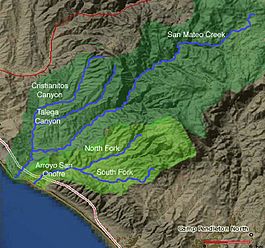Los Alamos Canyon Creek facts for kids
Quick facts for kids Los Alamos Canyon Creek |
|
|---|---|

Map of San Mateo Creek and Arroyo San Onofre drainage basins. San Mateo Creek basin is in dark green.
|
|
| Other name(s) | Los Alamos Canyon |
| Country | United States |
| State | California |
| Region | Riverside County |
| Physical characteristics | |
| Main source | southeastern slope of Elsinore Mountains 2,300 ft (700 m) 33°35′39″N 117°19′05″W / 33.59417°N 117.31806°W |
| River mouth | confluence with San Mateo Creek 1,312 ft (400 m) 33°33′04″N 117°23′38″W / 33.55111°N 117.39389°W |
| Length | 7 mi (11 km) |
| Basin features | |
| Tributaries |
|
Los Alamos Canyon Creek is a small stream, sometimes called an arroyo, located in Riverside County, California. It's a branch, or tributary, that flows into a bigger stream called San Mateo Creek. You can find this creek within the beautiful Cleveland National Forest.
Where the Creek Begins
Los Alamos Canyon Creek starts high up in the Elsinore Mountains. Its source is about 2,300 feet (701 meters) above sea level. It begins in a canyon on the southern side of a mountain ridge. This ridge comes down from a peak called Elsinore Peak.
The Creek's Journey
The creek first flows south for a short distance. Then, it turns southwest and travels for about 4 miles (6.4 kilometers). After that, it makes another turn and flows west for 3 miles (4.8 kilometers). This part of its journey takes it down a place known as Los Alamos Canyon. Finally, Los Alamos Canyon Creek meets and joins San Mateo Creek. This meeting point is about 1,312 feet (400 meters) above sea level.
Other Streams Joining In
Los Alamos Canyon Creek has one named stream that flows into it, called Wildhorse Canyon Creek. Besides that, two other unnamed streams also join it. These unnamed streams come down from the Elsinore Mountains. Another unnamed stream flows into Los Alamos Canyon Creek from the western part of the Santa Rosa Plateau. This stream also drains the eastern slope of a high area called Squaw Mountain. It flows north to meet the creek where it turns west.

